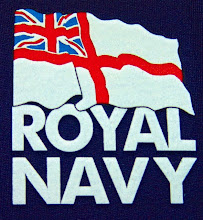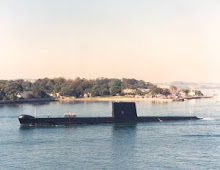The Royal Navy's submarine force can strike against ships and submarines as well as providing support for land operations. Unseen and unheard submarines can pinpoint targets up to 1,000 miles away. They are the UK's strategic nuclear deterrent.
| | 1901 | Holland one, the Royal Navy’s first submarine, fitted with a single torpedo tube, was born at Vickers, Sons & Maxim Ltd. (now BAE Systems Marine, Barrow) amidst great controversy in an era when the submarine was regarded as the weapon of the weaker power. ‘Submarining was no occupation for a gentleman’. |
| 1902-08 | Submarines quickly became established in the fleet but were still regarded with some disdain despite the fact that they had sounded the death-knell for the mighty DREADNOUGHTS. Even so they still remained relatively primitive craft with three white mice warning of dangerous petrol exhaust gases. | |
| | 1908-14 | Diesel engines made them safer and longer ranged. Boats became bigger and more powerfully armed. Although viewed primarily as defensive platforms, forward thinkers such as Lord Fisher pushed for the ‘overseas’ and ‘fleet escort’ submarine |
| | 1914-18 | The Royal Navy entered WWI with 100 submarines. Many famous exploits completed (five Victoria Crosses won) and a number of future admirals made their mark (eg Max Horton). Losses (54 boats) were relatively severe |
| | 1918 | A time of experimentation which saw submarines being driven at high speed by steam propulsion; one being fitted with a 12 inch gun; and another carried its own aircraft. Many of these submarines were lost in peacetime accidents. Thus the first stab at the ‘fleet escort’ missed its mark |
| | 1918-39 | A period of consolidation. Overseas squadrons were established which maintained British presence around the globe. A significant number of new classes of submarine were built to fulfil the task. |
| | 1939-45 | The Royal Navy entered W.W.II with 100 submarines. Many campaigns fought and won but at tremendous cost and sacrifice. Chances of not returning from patrol during 1943/44 were 65%. Nine Victoria Crosses were won. Once again many post war admirals emerged from the ranks of the survivors |
| | 1945-58 | Start of the Cold War. Ageing submarines held the line, but it was recognised, not least by Earl Mountbatten, that nuclear power held the key to counter the growing, eventually huge, Soviet submarine threat. |
| | 1958 | HMS DREADNOUGHT was built in Barrow by Vickers. She established a line of outstanding SSNs (nuclear powered fleet submarines) which were to play a pivotal role during the cold war. Their contribution, in partnership with their USN colleagues, was to confront the potential enemy wherever he went. |
| | 1968 | HMS RESOLUTION conducted the first of 229 unbroken Polaris deterrent patrols. This was a brilliant achievement and vital to the national interest at a time of great global uncertainty. |
| | 1982 | RN submarines, most notably HMS CONQUEROR, played a vital part during the Falklands conflict. The Commander in Chief was Admiral of the Fleet Lord Fieldhouse (the most senior submariner in history), and the task group was commanded by another submariner, Admiral Sir Sandy Woodward |
| | 1991
| The cold war, fought to a great degree beneath the waves, was won. |
| | 1995 | Strategic nuclear deterrent patrols continue with the first Vanguard Class patrols, equipped with ‘Trident’ ballistic missiles. |
| | 2001+ | 2001 marked the laying down of Astute - the first of a new generation of attack submarines that will never require refuelling at any time throughout their 25 year service history. The proud and powerful descendants of the tiny Holland One, equipped with ‘Trident’ ballistic missiles, Tomahawk land attack missiles, Sub-Harpoon anti-ship missiles, and GEC-Marconi Spearfish torpedoes maintain the vigil for peace............ |
A TRIBUTE TO THE PAST
The Royal Navy Submarine Museum looks after the heritage of a remarkable service whose reluctant conception and fragile birth into the Royal Navy in 1901 established the fighting service that today operates the most powerful ships in the Fleet and maintains the strategic and sub-strategic National Deterrent.
How we are regarded:
"The crews of all submarines captured should be treated as pirates and hanged".
The words of Admiral Sir Arthur Wilson VC, the Controller of the Navy, reveal why the Jolly Roger is the emblem of the Royal Navy Submarine Service. The Museum celebrates those pioneers who daily risked their lives to prove the submarine a viable and successful craft. By the end of World War 1 the submarine had truly come of age. Five of the Service’s fourteen Victoria Crosses had been won, the first by Lieutenant Norman Holbrook, Commanding Officer of HMS B11.
Rudyard Kipling recognised the extraordinary social change that the submarine had brought about in the Royal Navy when he wrote ....the submarine has created its own type of officer and man - with language and tradition apart from the rest of the Service, and yet at heart unchangingly of the Service.
By the end of World War Two the Submarine Service had added a further nine Victoria Crosses and numerous battle honours to an ever growing list. Winston Churchill recognised the courage and sacrifice of the men of the Submarine Service when he said Great deeds are done in the air and on the land, nevertheless there is no part to be compared to your exploits.
Since the end of the Second World War the Royal Navy Submarine Service has assumed the role of Peacekeeper. Its Attack and Deterrent submarines played a vital role during the Cold War and the contribution these vessels have made were to be summed up by the Daily Telegraph in 1967 HMS Resolution, in making the first dive of her patrol into the waters of a troubled world, will be taking out on behalf of the nation the best insurance policy it has ever had.
Sourced from http://www.solarnavigator.net/royal_navy_submarines.htm










.jpg)







No comments:
Post a Comment